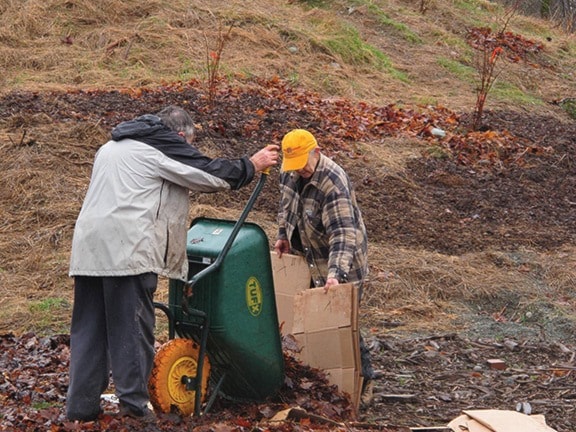Cara Smith special to the Gazette
The Cowichan Lake Community Garden (located beside the lower ball field at Centennial Park) will gladly accept your unwanted leaves and Halloween pumpkins.
Leaves, easily turned into protective mulch, soil-enhancing leaf mold or rich compost, are the fall season’s gift to the composter. After the last tomatoes are picked, the standing greens harvested, the squash brought in and the carrots pulled, nature provides a bounty that assures the next year’s crops will have the best soil possible.
Leaves have long been a treasure for gardeners: easily available, rich in nutrients, an effective mulch in winter and summer and, once decomposed, extremely beneficial to the soil. Pound for pound, the leaves of most trees contain twice the mineral content of manure. Because they’re a form of organic roughage, they can dramatically improve drainage and aeration of the soil. And they provide the perfect nutrition for beneficial microbes. In short, they make soil come alive.
Leaves are rich in the trace elements your soil needs. Trees are an effective mineral extractor, putting down deep and intricate root systems that funnel calcium, magnesium, potassium and phosphorus from the soil into their trunks and out to its leaves.
Fifty to 80 per cent of all the nutrients trees extract from the ground end up in the leaves. Gathered at their peak and composted correctly, leaves will transfer this nutrition to your soil.
What you intend to make with your leaves will determine the process you use. Many gardeners, especially those with abundant access to leaves, will have use for all three leaf products: compost, mold and mulch. Some will be looking only to make compost to enrich their soil. Gardeners with soil drainage problems will want to make leaf mold to improve the crumb and friability of their soil. Those with perennial plantings and extensive shrubbery will want leaf mulch to protect their plants and improve the soil’s water holding capabilities.
To make quality compost, leaf shredding is essential. This can be done by commercial shredders, which are notoriously expensive, noisy and fragile. Or shredding can be done with your home lawn mower. Don’t be content to run over your leaves once. Maximum shredding is important for quick breakdown. It’s easier if you employ help to pile up the leaves again once you’ve passed over them with the mower. Several passes will give you a fine, quick-to-decompose product. This is true if you’re making compost or leaf mold. In a pinch, a Weed Whacker or other line trimmer can be used to reduce leaves to a more compostable size.
If using leaves as mulch, they can be applied directly under trees, shrubs and plantings to protect the soil and provide insulation from the cold. Loft is important; the higher the pile and the more air trapped inside it, the better the insulating properties. Several inches is a good start.
Remember that leaves generally increase the acidity of soil. It’s a good idea to test soils in the spring and add lime or other alkaline substances if your pH is not to your plants’ liking. If using whole leaves or those not finely shredded, you’ll want to pull them back in the spring to allow the soil to warm.
Unshredded leaves can also make a sort of canopy over soils, allowing moisture to run-off and not get to the ground. Finely shredded leaves tend to work themselves into the soil and encourage moisture absorption. Also, shredded leaves will not inhibit the spring soil warming process as much.
Making leaf mold is similar to making compost. Piling leaves in heaps or in bins and cages is about all that’s necessary. Keep the piles uniformly moist. Turning them on occasion is helpful but not necessary. Matting, a problem with leaf-only piles, is minimized by frequent turning. Keeping the pile under a plastic tarp will help conserve heat and moisture. Be sure that the pile has access to air. Even piled in cages, leaves can take three years to reach optimum condition. But if you shred finely, turn the pile and keep it uniformly moist, you’ll have usable product in six to 12 months.
Leaf mold can also be made in plastic bags by filling lawn bags with shredded leaves, dampening and poking a few holes to let in air.
Making leaf compost isn’t different than making other compost. Bins, cages, piles and tumblers will all give satisfactory results though at different speeds. Because leaves are mostly carbon (60 parts carbon to one part nitrogen) more attention must be paid to the carbon-nitrogen balance. Not only will the right ratio of leaves to green material or manure yield a more nutritious product, it will also give you compost more quickly.
Chopping and mixing leaves with other brown and green ingredients will speed decomposition by four times. Five parts leaves (brown-carbon) to one part manure (green-nitrogen) will get your compost pile up and hot. Using only grass clippings requires five part leaves to two or three parts clippings. Kitchen waste including coffee grounds and those last trimmings from your garden will also increase the nitrogen content of your pile.
But don’t over do it. Too much nitrogen will help make your heap smell or turn anaerobic. Being sure your pile gets enough oxygen will help prevent this problem. To avoid matting, frequent turning of leaf piles is a must. Turning distributes moisture among water-repellent leaves, making for more uniform decomposition.
If you have an abundance of leaves and don’t plan to use them yourself, or you have Halloween pumpkins to dispose of please consider dropping them off at the community garden this year, instead of the community dump. Please note, we cannot accept twigs or branches, leaves only.
Cara Smith is a member of Lake Community Garden. For more information contact 250-749-4296.
